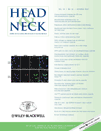Topographic description of an alternative insertion technique for percutaneous approach of cricopharyngeus muscle electromyography: A cadaveric and clinical study†
This work was presented as a platform presentation at the Eleventh Scientific Congress of European Association of Clinical Anatomy (EACA), June 29–July 1, 2011, Padova, Italy.
Abstract
Background
Cricopharyngeus is the only muscle for which electromyography is used in the differential diagnosis of swallowing disorders. Because of some practical difficulties, electrophysiologic tests for this muscle are not performed routinely. Thus we aimed to describe an alternative topographic way to reach the muscle easily.
Methods
On 10 cadavers, a spinal needle (20 G) and on 37 patients a concentric needle electrode (26 G) were used. The needle was inserted percutaneous at the level of the superior border of the cricoid cartilage, anterior to the anterior border of the sternocleidomastoid muscle at 60 degrees angle to the frontal plane in the posteromedial direction.
Results
We reached the muscle in all cadavers. In all of the patients, the needle entered the muscle on the first attempt; that was confirmed by electromyographic responses.
Conclusion
Our results show that this method can be useful for the practical application of cricopharyngeus muscle electromyography. © 2012 Wiley Periodicals, Inc. Head Neck, 2012




